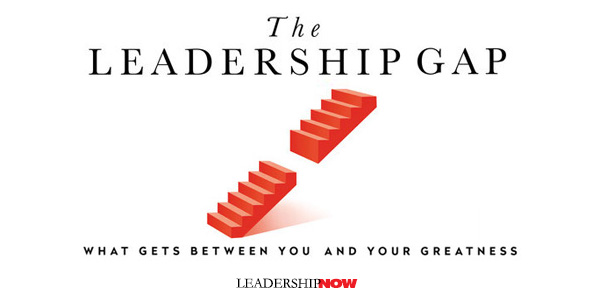
How to Avoid Your Leadership Gap

T
HE GAP IN OUR LEADERSHIP arises as a result of the disconnect between how we think people are experiencing our leadership and how they are actually experiencing our leadership. And where we find that disconnect we limit or even derail our leadership potential.
In The Leadership Gap, Lolly Daskal addresses this gap—what it is, why it happens, and what we can do about it. The gap is always there but at some point, it comes the surface to sabotage us. What if we don’t know what we think we know?
The problem is that one day, suddenly, what once worked so well to propel their rise stops working. And the very same traits that had worked for them actually start working against them.
It is at this point that we need to begin asking ourselves some questions. “What is the gap between who I am and who I want to be, and do I know what it is I still need to learn?” In short, “Who am I being?” We need to rethink how our behaviors are perceived by those around us. And when there is that gap between how we want to be perceived and how we are actually being perceived, we need to take action. “Learning to recognize your leadership gap is the factor that determines your greatness as a leader.” Sometimes we overuse a strength and sometimes we drift into the shadow side of our strengths. Either way, an understanding of what drives can give us the insight we need to avoid our leadership gaps.
Daskal invites us to look at who we are being and the instincts that drive our behaviors. The “shadow” you. She has developed seven leadership archetypes to help us gain some clarity as to what drives our beliefs and therefore our behaviors. We aren’t necessarily one type as we tend to shift from one to another depending on the circumstances but “we tend to lean repeatedly toward the same archetype persona.”
The Seven Archetypes
 The Rebel who is driven by confidence. “How can I push the envelope?” The gap is self-doubt. The gap archetype is The Imposter who is so insecure they play havoc with their mind because they have self-doubt. The key to the Rebel’s success is confidence, but self-doubt that often accompanies great success, undermines their confidence and they act out of the imposter syndrome. They undermine their leadership thus keeping them from achieving greatness.
The Rebel who is driven by confidence. “How can I push the envelope?” The gap is self-doubt. The gap archetype is The Imposter who is so insecure they play havoc with their mind because they have self-doubt. The key to the Rebel’s success is confidence, but self-doubt that often accompanies great success, undermines their confidence and they act out of the imposter syndrome. They undermine their leadership thus keeping them from achieving greatness.
 The Explorer who is fueled by intuition. “What can I discover?” The gap is manipulation. The gap archetype is The Exploiter who manipulates every chance they get just so you will not know how powerless they really feel. The tendency for the Explorer is to use their intuition to manipulate others to gain control. Daskal notes, “Whereas intuition makes things better for others, manipulation is always about making things better for you.”
The Explorer who is fueled by intuition. “What can I discover?” The gap is manipulation. The gap archetype is The Exploiter who manipulates every chance they get just so you will not know how powerless they really feel. The tendency for the Explorer is to use their intuition to manipulate others to gain control. Daskal notes, “Whereas intuition makes things better for others, manipulation is always about making things better for you.”
 The Truth Teller who embraces candor. “Where should I speak up?” The gap is suspicion. The gap archetype is The Deceiver who is suspicious about everyone because they cannot trust themselves to speak the truth. Discovering the truth and then speaking up for what is right is never easy but when we find we have been deceived, we can become paranoid and suspicious of others undermining our influence. We can become a kind of victim that will not speak up when we need to because of our paranoia.
The Truth Teller who embraces candor. “Where should I speak up?” The gap is suspicion. The gap archetype is The Deceiver who is suspicious about everyone because they cannot trust themselves to speak the truth. Discovering the truth and then speaking up for what is right is never easy but when we find we have been deceived, we can become paranoid and suspicious of others undermining our influence. We can become a kind of victim that will not speak up when we need to because of our paranoia.
 The Hero who embodies courage. “Where is courage needed?” The gap is fear. The gap archetype is The Bystander who is too fearful to be brave, too conservative to take a risk, and too cautious to take a stand. Once enabled by courage, they are now sidelined by fear. “Most of us not really afraid of being brave—we are afraid of what it takes to be brave. We are not really afraid of losing everything—we are afraid of what will happen when we have nothing.”
The Hero who embodies courage. “Where is courage needed?” The gap is fear. The gap archetype is The Bystander who is too fearful to be brave, too conservative to take a risk, and too cautious to take a stand. Once enabled by courage, they are now sidelined by fear. “Most of us not really afraid of being brave—we are afraid of what it takes to be brave. We are not really afraid of losing everything—we are afraid of what will happen when we have nothing.”
 The Inventor who is brimming with integrity. “How can we make this better?” No matter what you do you will be “held accountable and responsible as people. Everything in business, leadership, and success is founded on the virtue of integrity—it is the force that leads the way.” The gap is corruption. The gap archetype is The Destroyer who is morally corrupt. While an Inventor puts their personal values into practice, if those values become corrupted, usually by forces such as ego, personal gain, or anger, they destroy the organization from within. The Destroyer advocates cutting corners, quick fixes and compromising quality and standards. “The Inventor maintains his or her integrity while thinking outside the box.”
The Inventor who is brimming with integrity. “How can we make this better?” No matter what you do you will be “held accountable and responsible as people. Everything in business, leadership, and success is founded on the virtue of integrity—it is the force that leads the way.” The gap is corruption. The gap archetype is The Destroyer who is morally corrupt. While an Inventor puts their personal values into practice, if those values become corrupted, usually by forces such as ego, personal gain, or anger, they destroy the organization from within. The Destroyer advocates cutting corners, quick fixes and compromising quality and standards. “The Inventor maintains his or her integrity while thinking outside the box.”
 The Navigator who trusts and is trusted as they guide people to where they need to go. “How can we get to where we need to go?” The gap is arrogance. The gap archetype is The Fixer who a chronic rescuer no one trusts They want to help too much, fix too much and rescue too much. “Navigators have a way of making the complicated simple, and the simple understandable. They inspire trust. But their ability and confidence to know where to go and become an arrogance that attempts to control others—to do for others what they need to be doing themselves.
The Navigator who trusts and is trusted as they guide people to where they need to go. “How can we get to where we need to go?” The gap is arrogance. The gap archetype is The Fixer who a chronic rescuer no one trusts They want to help too much, fix too much and rescue too much. “Navigators have a way of making the complicated simple, and the simple understandable. They inspire trust. But their ability and confidence to know where to go and become an arrogance that attempts to control others—to do for others what they need to be doing themselves.
 The Knight for whom loyalty is everything and will stand beside you and will serve you before they serve themselves. “How can I serve you?” The gap is self-serving. The gap archetype is The Mercenary who is self -serving and put their own needs before those of the team, the business or the organization. Often the transition from serving to self-serving is subtle. “Loyal employees become disloyal one infraction at a time. Only after unfaithfulness shapes itself does the self-serving attitude emerge in a way it can be detected and deciphered.”
The Knight for whom loyalty is everything and will stand beside you and will serve you before they serve themselves. “How can I serve you?” The gap is self-serving. The gap archetype is The Mercenary who is self -serving and put their own needs before those of the team, the business or the organization. Often the transition from serving to self-serving is subtle. “Loyal employees become disloyal one infraction at a time. Only after unfaithfulness shapes itself does the self-serving attitude emerge in a way it can be detected and deciphered.”
Daskal reminds us that understanding our weaknesses is our greatest strength. From these seven archetypes, we can see how each has powerful abilities and hidden impediments. By knowing the gaps we can get into we can better use our strengths to achieve our own leadership greatness.
Daskal explains each of these archetypes in detail and importantly how we avoid these gaps. She describes what the positive looks like and what the negative looks like with examples for each.
The Leadership Gap provides the antidote for leading on autopilot. Daskal provides insight into our behaviors and beliefs that can if not managed properly can derail even the most talented and successful leaders. Confronting and avoiding our leadership gaps is the key to attaining long-term leadership success.
* * *

Like us on
Instagram and
Facebook for additional leadership and personal development ideas.
* * *




Posted by Michael McKinney at 03:03 PM
Permalink
| Comments (0)
| This post is about Leadership Development
, Personal Development










